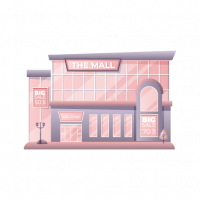Understanding Shopper Behavior | Mall Media | Digitally | Elyts

In the evolving landscape of retail, understanding shopper behavior is no longer a luxury—it's a necessity. With brick-and-mortar stores striving to compete with the personalized experiences of e-commerce, malls are turning to real-time analytics to gain valuable insights into customer preferences, patterns, and pain points. Real-time mall analytics is transforming how retailers operate, market, and connect with their customers.
What is Real-Time Mall Analytics?
Real-time mall analytics refers to the use of digital
technologies and data collection systems—such as Wi-Fi tracking, foot traffic
sensors, video analytics, and mobile apps—to monitor and analyze shopper
behavior as it happens. These tools provide mall operators and retailers with
up-to-the-minute insights into how people move, interact, and engage within a
shopping environment.
Why Real-Time Analytics Matter in Retail Spaces
Unlike traditional surveys and sales data, real-time
analytics offers a more comprehensive and dynamic view of shopper behavior.
Here’s why it’s becoming essential:
- Immediate
Insights: Retailers can react quickly to patterns, such as adjusting
staffing during busy hours or changing promotional placements.
- Improved
Layout Optimization: Understanding how shoppers navigate a mall helps
refine store placement, signage, and common areas to maximize engagement.
- Personalized
Experiences: By tracking behaviors and preferences, malls can offer
tailored promotions and alerts via apps or digital kiosks.
- Tenant
Support: Mall operators can provide retailers with actionable data to
help improve conversion rates, dwell time, and footfall.
Key Shopper Behaviors Tracked
Real-time mall analytics systems can monitor a variety of
customer behaviors, including:
- Foot
Traffic Patterns: Where shoppers go, how long they stay, and which
areas they avoid.
- Dwell
Time: How long people spend in certain zones or stores, indicating
interest levels.
- Entry
and Exit Points: Understanding which entrances attract the most
visitors can inform marketing and leasing decisions.
- Repeat
Visits: Tracking loyal customers versus one-time visitors helps refine
loyalty programs and marketing strategies.
- Conversion
Rates: Linking traffic data with point-of-sale systems helps measure
how many visitors turn into buyers.
Technologies Powering Real-Time Analytics
Several advanced technologies make these insights possible:
- Video
Cameras with AI: Monitor foot traffic and demographic trends without
invading privacy.
- Wi-Fi
& Bluetooth Tracking: Detect mobile devices and follow movement
paths anonymously.
- Interactive
Kiosks and Mobile Apps: Encourage engagement while collecting data on
preferences and behaviors.
- Beacons
and IoT Devices: Provide hyper-localized data and targeted messaging.
Benefits for Retailers and Mall Operators
- Optimized
Marketing Campaigns
Real-time data allows for precise targeting and campaign refinement based on actual customer behavior rather than assumptions. - Enhanced
Customer Experiences
With a deeper understanding of what customers want, malls can create more inviting, efficient, and enjoyable environments. - Data-Driven
Leasing Decisions
Mall management can use foot traffic data to justify rental rates, attract premium tenants, or determine which areas need revitalization. - Crisis
and Flow Management
During peak times or emergencies, real-time analytics helps manage crowd control and optimize cleaning and maintenance schedules.
Ethical Considerations and Data Privacy
While the benefits are substantial, it's crucial to
prioritize transparency and compliance. Real-time mall analytics should follow
strict data privacy regulations, anonymizing data and informing users of
tracking where appropriate. Gaining consumer trust is essential to ensure the
long-term success of these systems.
The Future of Retail Intelligence
As technology continues to evolve, the integration of
artificial intelligence, machine learning, and predictive analytics will
further enhance the power of real-time data. Future malls may even use
augmented reality or digital twins to simulate and optimize shopper experiences
before implementing changes.
Conclusion
Real-time mall analytics is no longer just a competitive
edge—it’s becoming the backbone of modern retail strategy. By offering a deeper
understanding of shopper behavior, these insights empower mall operators and
retailers to create more personalized, efficient, and successful environments
for consumers. As the line between online and offline experiences continues to
blur, harnessing the power of real-time analytics will define the winners in
the retail space.
Elyts Advertising and Branding Solutions | www.elyts.in (India) | www.elyts.agency (UAE)






















Leave a Comment